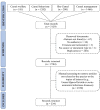Dromedary camel's welfare: literature from 1980 to 2023 with a text mining and topic analysis approach
- PMID: 38026661
- PMCID: PMC10665734
- DOI: 10.3389/fvets.2023.1277512
Dromedary camel's welfare: literature from 1980 to 2023 with a text mining and topic analysis approach
Abstract
Dromedary camels are the preferable livestock species in the arid and semi-arid regions of the world. Most of the world's camel populations are managed under a subsistence/extensive system maintained by migratory pastoralists but intensification is getting more frequent. Even though recently the welfare of camels has been receiving more attention, in many countries there are no regulations to protect their health and welfare. The objectives of this article were to explore the main research topics related to camel welfare, their distribution over time and to highlight research gaps. A literature search was performed to identify records published in English from January 1980 to March 2023 on Dromedary camel welfare via Scopus®, using "Camel welfare," "Camel behaviour," "She-camel" and "Camel management" as search words. A total of 234 records were retained for analysis after automatic and manual screening procedures. Descriptive statistics, text mining (TM) and topic analysis (TA) were performed. The result shows that even though there were fluctuations between years, records on camel welfare have increased exponentially over time. Asia was the region where most of the corresponding authors were located. The first five most frequent words were, "milk," "calv," "behaviour," "femal," and "breed," the least frequent word was "stabl." TA resulted in the five most relevant topics dealing with "Calf management and milk production," "Camel health and management system," "Female and male reproduction," "Camel behaviour and feeding," and "Camel welfare." The topics that contained the oldest records were "female and male reproduction" and "camel health and management system" (in 1980 and 1983, respectively), while the topic named "camel behaviour and feeding" had the first article published in 2000. Overall, even though topics related to camel behaviour and welfare are receiving more attention from academia, research is still needed to fully understand how to safeguard welfare in Dromedary camels.
Keywords: camelids; husbandry; machine learning; production; research.
Copyright © 2023 Masebo, Zappaterra, Felici, Benedetti and Padalino.
Conflict of interest statement
The authors declare that the research was conducted in the absence of any commercial or financial relationships that could be construed as a potential conflict of interest. The author(s) declared that they were an editorial board member of Frontiers, at the time of submission. This had no impact on the peer review process and the final decision.
Figures








References
-
- Ouajd S, Kamel B. Physiological particularities of dromedary (Camelus dromedarius) and experimental implications. Scand J Lab Anim Sci. (2009) 36:19–29. doi: 10.23675/sjlas.v36i1.165 - DOI
-
- Babiker M. Abundance and economic potential of camels in the Sudan. J Arid Environ. (1984) 7:377–94. doi: 10.1016/S0140-1963(18)31355-7 - DOI
-
- Faye B, Bengoumi M, Cleradin A, Tabarani A, Chilliard Y. Body condition score in dromedary camel: a tool for management of reproduction. Emir J Food Agric. (2001) 13:1–6. doi: 10.9755/ejfa.v12i1.5193 - DOI
Publication types
LinkOut - more resources
Full Text Sources

